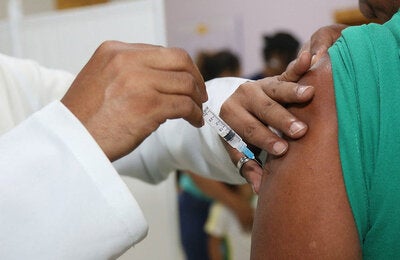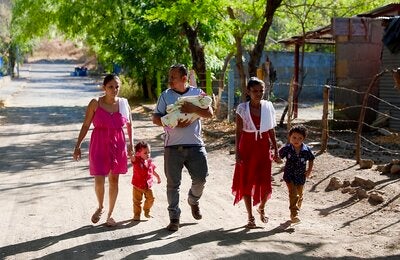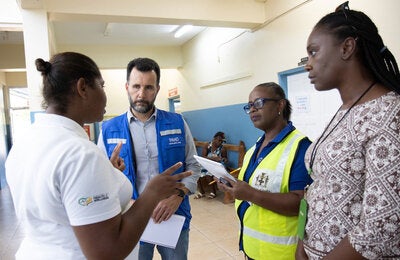
Dengue, malaria and Chagas disease. Leishmaniasis, schistosomiasis and yellow fever. Chikungunya, lymphatic filariasis, onchocerciasis and West Nile virus. These are 10 vector-borne diseases carried by mosquitoes, ticks, flies and other vectors that put one of every two people in the Americas at risk.
Dengue: a potentially lethal disease transmitted through the bites of infected mosquitoes
- Dengue and theAedes aegypti mosquito are present in all countries of the Americas except Canada and continental Chile. Uruguay has no cases but does haveAe. Aegypti
- About 500 million people are at risk in the Americas
- Incidence rose from 16 cases per 100,000 people to 218 cases per 100,000 between 1980 and 2000-2010.
- In 2013 (an epidemic year) there were 2.3 million cases (430.8 per 100,000) and 1,280 deaths in the hemisphere.
Malaria: caused by the Plasmodium parasite, transmitted through bites of Anopheles mosquitoes
- Present in 21 countries of the Americas
- 145 million people in the region at risk of contracting the disease
- Cases declined 60% and deaths 72% between 2000 and 2012
- Argentina, Belize, Costa Rica, Ecuador, El Salvador, Mexico and Paraguay are in the process of eliminating malaria
Chagas: a parasitic disease caused by T. cruzi and transmitted mainly through the bites of the so-called "kissing bug"
- Present in 21 countries of the Americas
- 65 million people in the region live in areas of exposure
- An estimated 6-8 million people are infected in the region
- Each year, an average 28,000 cases are reported, and 8,000 newborns become infected in the Americas
Leishmaniasis: caused by the protozoan parasite Leishmania, transmitted through mosquito bites
- Present in 19 countries of the Americas
- 4 of the 10 countries in the world that report 75% of all cutaneous cases are in the Americas: Brazil, Colombia, Peru and Nicaragua
- An average 60,000 cases of cutaneous and mucosal leishmaniasis are diagnosed each year in the Americas, and 4,000 visceral cases, with a case fatality rate of 7%.
Schistosomiasis: a chronic parasitic infection caused by small worms
- In the Americas, nearly 1.6 million children need preventive medication
- Endemic in Brazil, Venezuela, Suriname and Santa Lucia
- Suriname and Santa Lucia are close to interrupting transmission
- Available information indicates transmission has been interrupted in the Dominican Republic, Puerto Rico, Montserrat, Antigua, Martinique and Guadaloupe
See Schistosomiasis fact sheet
Yellow fever: an acute viral hemorrhagic disease transmitted by infected mosquitoes
- Globally there are some 200,000 cases yearly, causing 30,000 deaths
- From 2000 to 2013, more than 1,100 confirmed cases were reported in the Americas
- Cases were reported from 13 countries in this hemisphere
- From 1985 to 2012, 95% of all cases in the region were reported by Peru (54%), Bolivia (18%), Brazil (16%), and Colombia (7%).
Chikungunya: a viral disease transmitted by mosquitoes
- Found for the first time in the Americas in December 2013
- By March 2014, had spread to Anguilla, British Virgin Islands, Dominica, French Guiana, Guadeloupe, Martinique, St. Barthelemy, St Martin/St Maarten. Aruba has reported one imported case
- More than 15,000 suspected cases have been reported in the Caribbean.
Lymphatic filariasis: a parasitic infection caused by worms and transmitted by Culex mosquitoes in the Americas
- Some 13.4 million people in the Americas are at risk of infection, 80% of them in Haiti
- Endemic in Brazil, the Dominican Republic, Guyana, and Haiti
- Guyana, Haiti, and the Dominican Republic provide mass administration of donated drugs for the disease
- Brazil has eliminated it in six states, with part of the metropolitan area of Recife now the only active area
See Lymphatic filariasis fact sheet
Onchocerciasis(river blindness): a parasitic disease transmitted by black flies
- Blindness from onchocersiasis has been eliminated in the Americas since 1995
- Colombia became the first country in the world to achieve verification of elimination of onchocerciasis transmission in 2013.
- Ecuador submitted a request for verification of elimination to PAHO/WHO in 2013
West Nile virus: transmitted to people primarily through the bite of infected mosquitoes.
- Eight in 10 people who become infected with WNV show no symptoms
- 286 people in the United States died of WNV in 2012 (CDC)
- Preliminary data for 2013 indicate over 1,200 cases of neuroinvasive disease and 114 deaths due to WNV
See West Nile virus fact sheet



